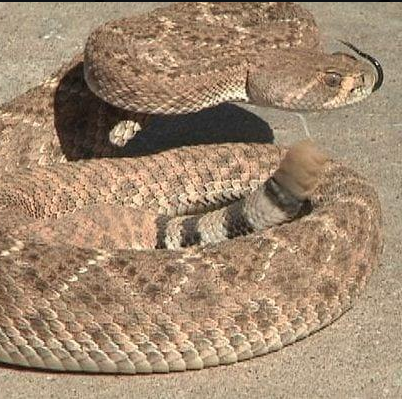But according to experts, that is not necessarily true. There are about 36 species of rattlesnakes in the USA, and may differ somewhat in their traits and habits. A young rattlesnake may not have rattles on its tail and some will strike without warning if they feel threatened or surprised. So it’s best to always be aware of your surroundings and to not rely on a rattle to warn you of a snake’s presence. Snakes love warmer days. As reptiles, their body temperature mirrors air temperature, so it’s common to begin seeing many more snakes even if the calendar tells us it’s not yet officially spring. In the warm deserts, rattlesnakes are most active from March through October. In the spring, they are active during daylight hours. As days become increasingly hot around early May, rattlesnakes become more active at night and spend the day in a spot of shade or a cool shelter. Regardless of the state in which you live, if you work, hike, fish, hunt, prospect for gold, metal detect, ride ATVs, etc. in rattlesnake country, you’re likely going to encounter some snakes this year. Keep in mind that snakes of many species are through hunkering down now that the weather is warmer, making human encounters more likely with ALL types of snakes. If you’re wondering how to deal with snakes you might find in your own backyard, keep in mind that nonpoisonous snakes are harmless. They eat mice, rats, and other pesky rodents you don’t want around. Having them near the house is a good thing. When disturbed, these harmless snakes usually just slither away. They prefer to avoid contact with humans. But you never know what type of snake you might encounter, so wear thick gloves and snake gaiters around your lower legs when weeding ground cover around the house, clearing brush, or working around timber or log piles. Always watch where you place your hands and feet when hiking, especially through tall weeds or in rocky areas. If you see a snake within five to six feet of you, make slow movements in the opposite direction of the snake. How to identify a rattlesnake:
Did you know that not all snakebites are equal? Some snakes deliver a bite with a small amount of venom and others can deliver a great deal. So-called dry bites contain no venom at all. If you are bitten, even if it doesn’t feel worse than a bee sting at the time, you won’t know how much or how little venom was injected, therefore, it’s imperative you get immediate medical attention.
Some great news coming from the medical community is that in the last couple of years, a new anti-venom called Anavip has become FDA-approved. The biggest difference is how it works in the bloodstream. It lasts longer in the body, so it can bind up the venom for a longer period of time. It essentially prevents patients from getting delayed bleeding abnormalities. That was the problem with the old product. It had a short duration of action, so there was still venom circulation. This new antidote works on some people who have allergies to certain medications. The cost of this newest anti-venom is about half the price of the older one, but at $1,200 a vial, it's still no bargain. Some snake bit victims need to be injected with 30 or more vials!
From your front yard to the hiking trail, it’s important to keep an eye out for snakes to avoid dangerous encounters. Just know that as temperatures rise, so will rattlesnake sightings. No need to avoid enjoying the great outdoors this season, just be more vigilant and prepared by wearing snake gaiters. Comments are closed.
|
RAZER GAITERS

 RSS Feed
RSS Feed
